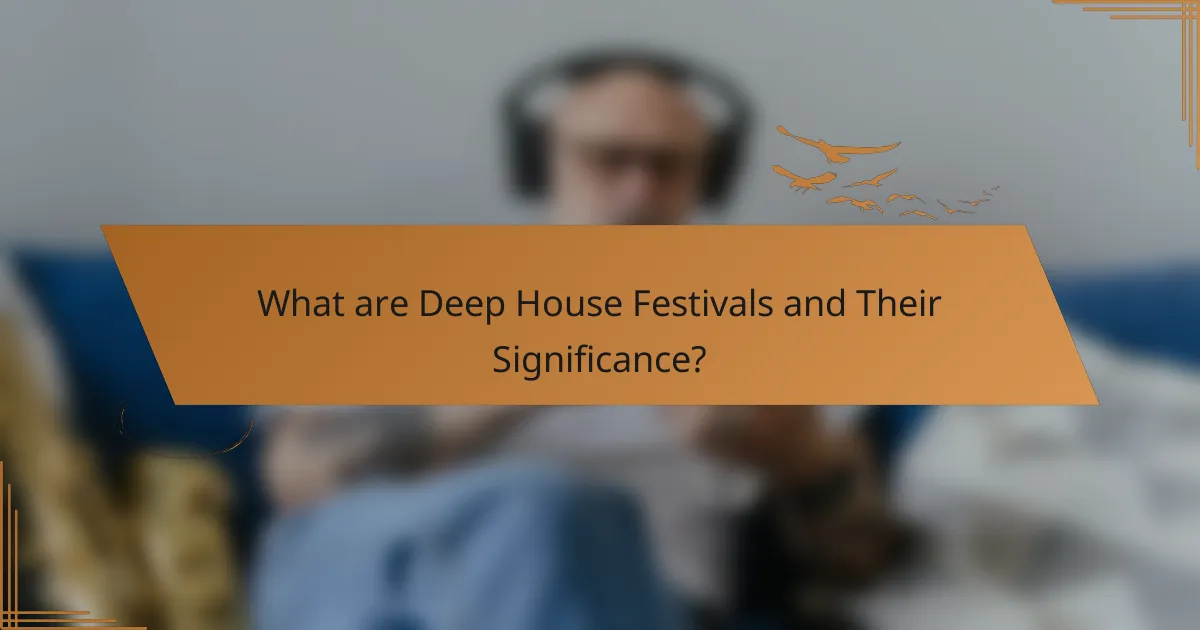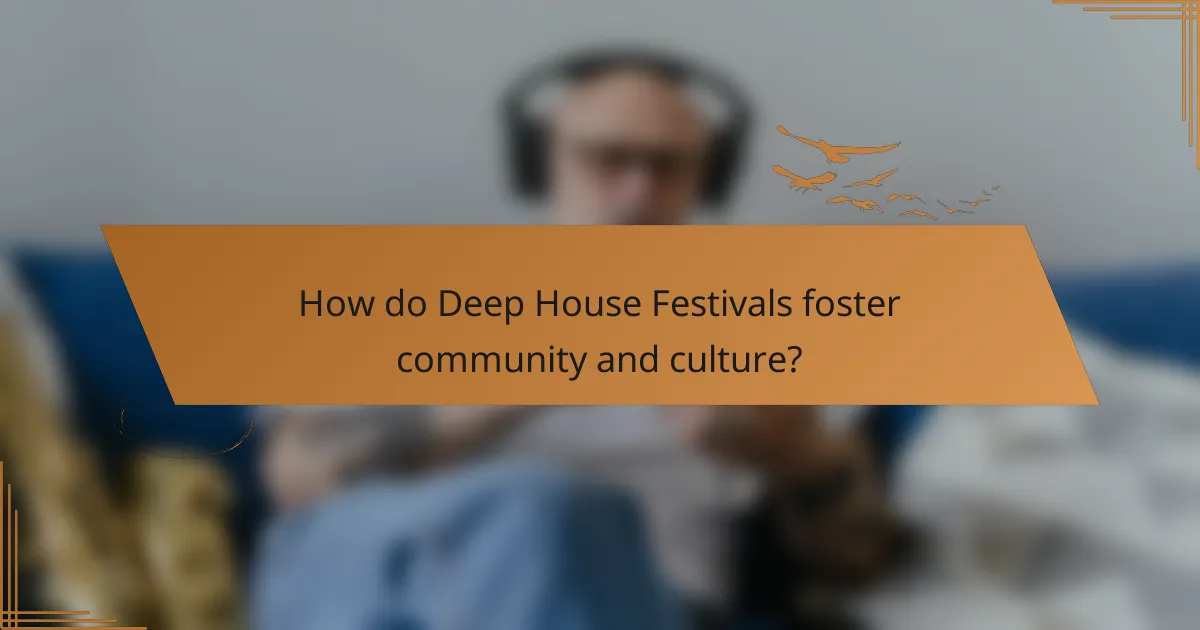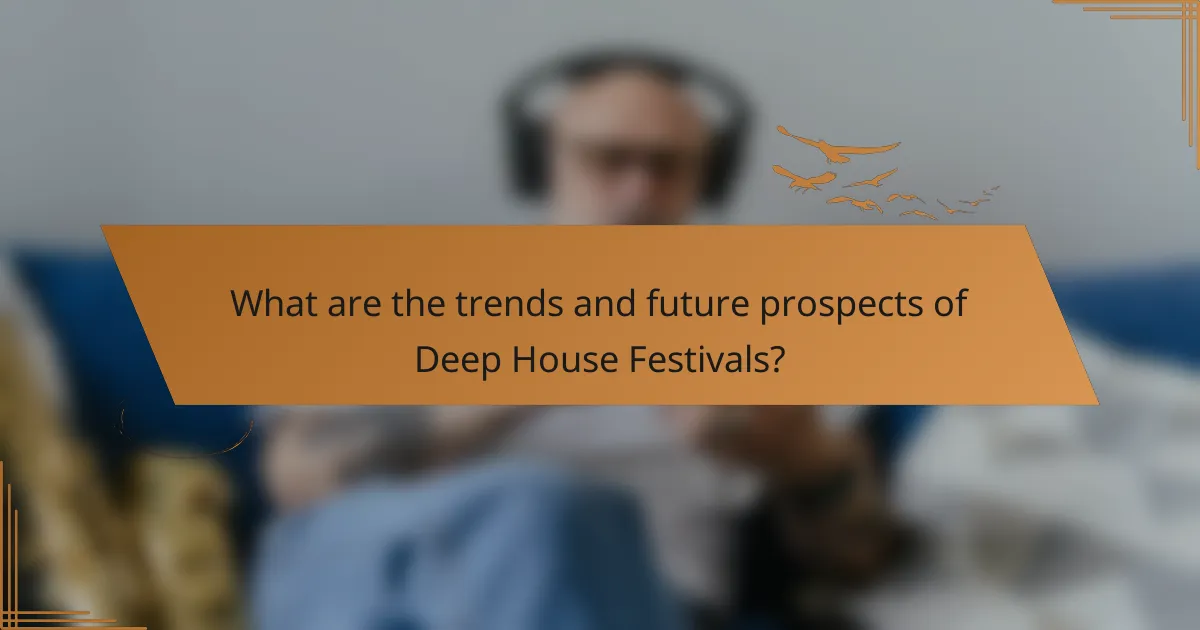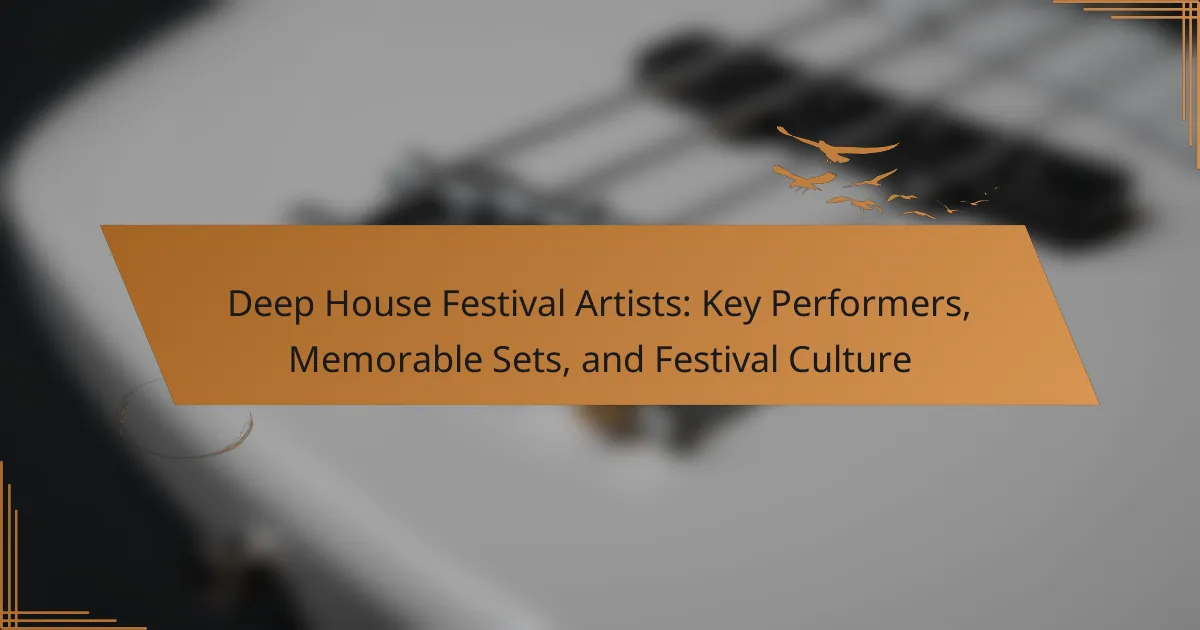Deep House Festivals are events centered around the deep house music genre, showcasing live performances from DJs and artists who specialize in this style. These festivals not only provide vibrant atmospheres for fans but also feature art installations, workshops, and community engagement activities that enhance the cultural experience. Key performers and memorable sets play a significant role in shaping festival culture, while the promotion of local and emerging artists fosters connections within the community. The rise in popularity of deep house festivals is influenced by evolving music tastes, technological advancements, and a focus on sustainability, indicating a promising future for these events in the global music scene.

What are Deep House Festivals and Their Significance?
Deep House Festivals are events dedicated to the deep house music genre. They feature live performances from DJs and artists specializing in deep house. These festivals create a space for fans to experience the music in a vibrant atmosphere. They often include art installations, workshops, and community engagement activities. The significance of these festivals lies in their ability to foster connections among fans and artists. They promote the deep house culture and its evolution in the music scene. Additionally, they provide a platform for emerging artists to showcase their talent. Festivals like Amsterdam Dance Event and Sonus Festival highlight the global appeal of deep house music.
How did Deep House Festivals originate?
Deep House Festivals originated from the evolution of deep house music in the 1980s. The genre developed as a subgenre of house music, emphasizing soulful melodies and complex harmonies. Early deep house artists, like Larry Heard and Frankie Knuckles, laid the groundwork for this sound. By the 1990s, deep house gained popularity in underground clubs and raves. This growing interest led to the organization of festivals dedicated to the genre. The first deep house festivals emerged in the early 2000s, showcasing both established and emerging artists. Festivals like the Amsterdam Dance Event began to feature deep house prominently. These events fostered a sense of community among fans and artists alike. Today, deep house festivals are celebrated worldwide, highlighting the genre’s enduring appeal.
What cultural influences shaped the emergence of Deep House Festivals?
Deep House Festivals emerged from a blend of cultural influences rooted in the evolution of house music. The genre originated in Chicago during the 1980s, influenced by disco, soul, and jazz. Artists like Frankie Knuckles and Larry Heard contributed to its development. The cultural backdrop included the [censured] community, which played a significant role in popularizing house music in dance clubs.
In the 1990s, deep house gained traction in Europe, particularly in the UK and Germany. The rise of rave culture and underground parties further propelled its popularity. Additionally, the incorporation of live instrumentation and vocal elements distinguished deep house from other electronic genres.
Globalization and the internet facilitated the spread of deep house music and festivals, allowing diverse audiences to connect. Today, deep house festivals reflect these rich cultural influences, showcasing a mix of international artists and local talent.
How have Deep House Festivals evolved over the years?
Deep House Festivals have evolved significantly since their inception in the late 1980s. Initially, these festivals were small gatherings focused on underground music culture. Over the years, they have expanded into large-scale events attracting thousands of attendees. The rise of digital music platforms has increased accessibility to deep house tracks and artists. This accessibility has led to a broader audience and greater diversity in festival lineups. Additionally, the incorporation of technology has enhanced the overall festival experience. Visuals, lighting, and sound systems have become more sophisticated, creating immersive environments. Major cities around the world now host annual deep house festivals, showcasing both established and emerging artists. The evolution reflects the genre’s growing popularity and cultural significance within the electronic music scene.
What role do artists play in Deep House Festivals?
Artists are central to Deep House Festivals as they provide the music that defines the event. They create the atmosphere and engage the audience through their performances. Artists often showcase their unique styles, contributing to the diversity of the festival. Their sets can include original tracks, remixes, and collaborations, enhancing the overall experience. Additionally, artists help attract attendees, as fans often follow specific performers. The presence of renowned artists can elevate the festival’s reputation and draw larger crowds. Festivals also serve as a platform for emerging artists to gain exposure. Overall, artists are essential for the festival’s success and cultural significance.
Who are the key performers in the Deep House scene?
Key performers in the Deep House scene include artists such as Black Coffee, Solomun, and Dixon. Black Coffee is renowned for his unique blend of Afro-house and deep house elements. Solomun has gained acclaim for his energetic sets and innovative productions. Dixon is celebrated for his deep, melodic sound and curatorial skills. Other notable names include Jamie Jones, Âme, and Peggy Gou. These artists frequently headline major festivals and clubs, contributing to the genre’s popularity. Their influence shapes the sound and culture of deep house music globally.
What attributes distinguish these artists from others?
The attributes that distinguish these deep house festival artists from others include their unique sound, performance style, and audience engagement. Each artist typically develops a signature sound that blends various sub-genres of deep house. This distinct musical identity sets them apart in a crowded field. Performance style is another key attribute; many artists incorporate live elements or improvisation, enhancing the experience for attendees. Audience engagement is crucial; successful artists often interact with fans during their sets, creating a memorable atmosphere. These factors contribute to their reputation and draw festival-goers to their performances.
What makes a memorable set at a Deep House Festival?
A memorable set at a Deep House Festival is characterized by a seamless blend of tracks. This blend creates an immersive experience for the audience. The artist’s ability to read the crowd enhances engagement. Live elements, such as vocals or instruments, add uniqueness to the performance. High-quality sound systems amplify the music’s depth and richness. Visual effects, like lighting and stage design, complement the auditory experience. A strong emotional connection with the audience fosters lasting memories. Finally, an artist’s charisma and stage presence can elevate the entire atmosphere.
How do artists create unique experiences during their performances?
Artists create unique experiences during their performances by integrating various elements. They often use innovative visual effects, such as light shows and projections, to enhance the atmosphere. Live improvisation adds spontaneity, making each performance distinct. Audience interaction plays a crucial role, as artists engage with fans through calls and responses. Unique setlists tailored to specific events further differentiate performances. Collaborations with other artists can introduce unexpected dynamics. Additionally, the venue’s ambiance influences the overall experience. These factors collectively contribute to memorable performances that resonate with audiences.
What are some iconic sets in Deep House Festival history?
Some iconic sets in Deep House Festival history include those by renowned artists like Black Coffee and Solomun. Black Coffee’s set at the 2018 festival was celebrated for its deep rhythms and unique blending of African sounds. Solomun’s performance in 2019 featured a seamless mix that captivated the audience and showcased his signature style. Additionally, the 2020 virtual festival included standout sets from artists like Peggy Gou, which were praised for their energy and innovative approach. These performances have become memorable highlights, reflecting the evolution of deep house music within the festival’s culture.

How do Deep House Festivals foster community and culture?
Deep House Festivals foster community and culture by creating immersive experiences that bring people together. These festivals often feature diverse lineups of artists that appeal to a wide audience. The shared love for deep house music cultivates a sense of belonging among attendees. Social interactions occur through dance, conversation, and collaboration, enhancing communal bonds. Many festivals also promote local artists, strengthening regional cultural identities. Additionally, workshops and art installations at these events encourage creative expression. Studies show that music festivals can improve mental well-being and social cohesion. This evidence highlights the vital role deep house festivals play in enhancing community and culture.
What elements contribute to the festival culture surrounding Deep House?
The elements contributing to the festival culture surrounding Deep House include music, community, and immersive experiences. Deep House music features smooth melodies and soulful vocals, creating a unique atmosphere at festivals. The community aspect is vital, as fans gather to share their passion for the genre. Festivals often showcase a diverse lineup of artists, enhancing the cultural experience. Immersive experiences like art installations and light shows complement the music, engaging attendees on multiple sensory levels. Events like the Amsterdam Dance Event and Sonar Festival highlight these elements, drawing large crowds and fostering a sense of belonging among fans.
How do attendees engage with artists and each other at these festivals?
Attendees engage with artists and each other at Deep House festivals through various interactive activities. They participate in live performances, where artists often encourage audience interaction. Attendees dance, sing, and respond to the music, creating a vibrant atmosphere. Social media platforms play a significant role in this engagement. Festival-goers share experiences and connect with artists online. Additionally, workshops and Q&A sessions facilitate direct communication between artists and attendees. Networking opportunities arise during after-parties and meet-and-greets. These interactions foster a sense of community among attendees, enhancing the overall festival experience.
What role does venue selection play in shaping festival culture?
Venue selection significantly influences festival culture. The choice of location impacts the overall atmosphere and experience. Different venues provide unique settings that can enhance or detract from the festival’s theme. For instance, outdoor spaces often promote a sense of freedom and connection to nature. Conversely, indoor venues can create an intimate and immersive environment.
The infrastructure of a venue also affects logistics, such as crowd management and accessibility. A well-chosen venue can accommodate more attendees, fostering a larger community feel. Historical and cultural significance of a venue can enrich the festival’s narrative. Festivals held in iconic locations often attract more attention and participation.
Moreover, the venue’s acoustics and layout influence the sound experience, which is crucial for music festivals. A venue that supports excellent sound quality enhances the audience’s enjoyment. In summary, venue selection is a critical factor that shapes the identity and culture of a festival, affecting everything from ambiance to audience engagement.
How do festivals impact the careers of Deep House artists?
Festivals significantly enhance the careers of Deep House artists. They provide exposure to larger audiences. This exposure can lead to increased fan bases. Festivals often feature multiple artists, creating networking opportunities. Collaborations may arise from these connections. Many Deep House artists gain bookings through festival performances. Successful sets can lead to higher demand for future gigs. Statistics show that artists who perform at major festivals often see a rise in streaming and sales.
What opportunities arise for artists during festivals?
Artists gain exposure during festivals. They perform in front of large audiences. This can lead to increased fan engagement. Festivals often attract media coverage. Artists may receive press attention and interviews. Networking opportunities are abundant at festivals. Collaborations with other artists can arise. Merchandise sales can increase due to festival attendance. Overall, festivals provide a platform for artistic growth.
How do festivals help in building a fan base for emerging artists?
Festivals help in building a fan base for emerging artists by providing exposure to large audiences. These events attract diverse crowds, increasing visibility for new talent. Live performances allow artists to showcase their unique sound and style. Engaging with fans in person fosters a deeper connection. Festivals often include promotional opportunities through social media and press coverage. This visibility can lead to increased streaming and sales. According to a study by the University of Southern California, 70% of festival attendees discover new artists at events. Thus, festivals serve as a crucial platform for emerging artists to expand their reach and grow their fan base.

What are the trends and future prospects of Deep House Festivals?
Deep House Festivals are witnessing a rise in popularity driven by evolving music tastes. The integration of technology, such as virtual reality experiences, is enhancing audience engagement. Additionally, a focus on sustainability is shaping festival operations, with many events adopting eco-friendly practices. Emerging artists are gaining more platforms, leading to diverse lineups that attract wider audiences. The influence of social media is significant, as it boosts festival visibility and creates community among fans. Collaborations between genres are becoming common, enriching the deep house sound. As festivals adapt to these trends, they are likely to expand globally, catering to diverse audiences. The future of Deep House Festivals appears promising with continued innovation and audience growth.
How are technology and innovation influencing Deep House Festivals?
Technology and innovation are significantly influencing Deep House Festivals by enhancing the overall experience for attendees. Advanced sound systems provide clearer audio quality, allowing for a more immersive listening experience. Visual technology, such as LED screens and projection mapping, creates stunning visual displays that complement the music. Mobile applications are streamlining festival navigation and scheduling for attendees. Social media platforms are facilitating real-time engagement and community building among fans. Innovations in ticketing, such as blockchain technology, are improving security and reducing fraud. Data analytics are being used to tailor lineups and programming based on audience preferences. These technological advancements are transforming how festivals are organized and experienced, making them more interactive and engaging.
What new formats or experiences are being introduced?
New formats and experiences in deep house festivals include immersive audio-visual installations. These installations enhance the sensory experience for attendees. Virtual reality environments are also being introduced, allowing fans to engage in unique ways. Additionally, live-streaming options are expanding access to performances globally. Interactive workshops and artist Q&A sessions are becoming more common. These formats foster deeper connections between artists and audiences. Collaborative performances featuring multiple artists are gaining popularity. These innovations reflect the evolving landscape of festival culture.
How is the audience demographic changing for these festivals?
The audience demographic for deep house festivals is becoming more diverse. Younger attendees are increasingly participating, with a notable rise in the 18-25 age group. This shift is partly due to social media influence and targeted marketing strategies. Additionally, there is a growing representation of women and non-binary individuals at these events. According to a 2022 survey by Resident Advisor, female attendance at electronic music festivals increased by 30% over the last five years. Cultural backgrounds among attendees are also becoming more varied, reflecting broader societal trends. This demographic change enhances the festival experience by fostering inclusivity and a wider range of musical tastes.
What can attendees expect at a Deep House Festival?
Attendees at a Deep House Festival can expect a vibrant atmosphere filled with music, art, and community. The festival typically features a lineup of renowned deep house DJs and producers. These artists create an immersive experience with their unique sounds and styles. Attendees will enjoy extended sets that allow for deep musical journeys. The festival environment often includes visually captivating stage designs and light shows. Additionally, there may be art installations and interactive experiences throughout the venue. Food and beverage vendors commonly offer a variety of options to enhance the festival experience. Overall, attendees can anticipate a celebration of deep house culture and music.
What are the essential tips for first-time festival-goers?
Stay hydrated throughout the festival. Festivals can last for hours, and dehydration is common. Bring a refillable water bottle to ensure you have access to water. Wear comfortable shoes to navigate the venue easily. Walking and standing for long periods is typical at festivals. Plan your schedule by reviewing the lineup in advance. This helps prioritize must-see artists and avoid missing performances. Arrive early to secure a good spot for popular acts. Crowds can grow quickly, especially for headliners. Keep your belongings secure to prevent theft. Use a crossbody bag or fanny pack for easy access. Familiarize yourself with the festival layout. Knowing where stages, restrooms, and food vendors are located enhances your experience. Lastly, embrace the festival atmosphere. Engage with fellow attendees and enjoy the music.
How can attendees enhance their overall festival experience?
Attendees can enhance their overall festival experience by actively engaging with the festival’s offerings. Participating in workshops and interactive sessions fosters deeper connections with the music and artists. Exploring food and craft vendors allows attendees to enjoy local culture and flavors. Arriving early provides opportunities to discover new artists and secure prime viewing spots. Networking with fellow attendees can lead to shared experiences and friendships. Utilizing social media to follow event updates keeps attendees informed about schedule changes and special announcements. Dressing comfortably and preparing for weather conditions ensures a more enjoyable time. Staying hydrated and taking breaks helps maintain energy levels throughout the event.
Deep House Festival Artists are central figures in events dedicated to the deep house music genre, showcasing their unique sounds and styles. This article provides an overview of the significance of deep house festivals, their origins, cultural influences, and evolution over the years. It highlights key performers, memorable sets, and the role of artists in fostering community and culture within these festivals. Additionally, the article explores trends, audience demographics, and essential tips for attendees to enhance their festival experience.
